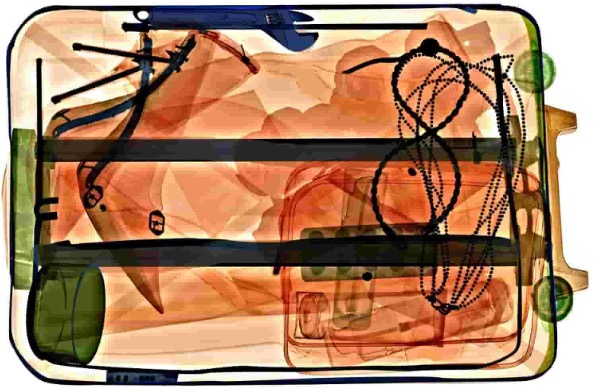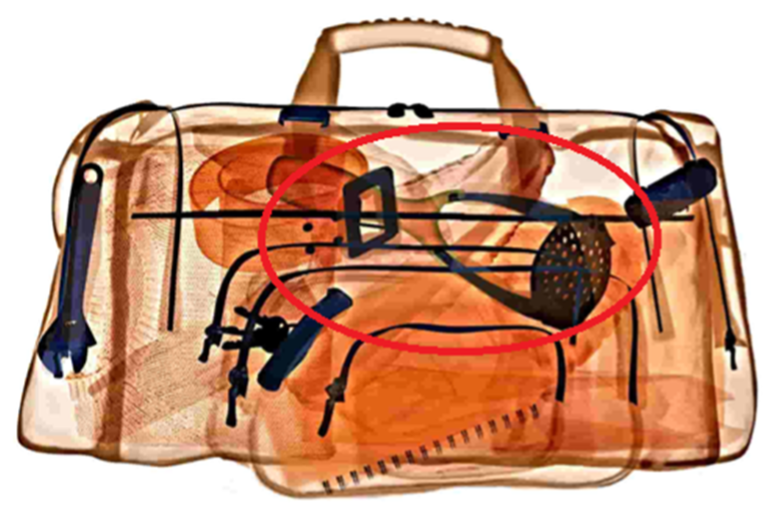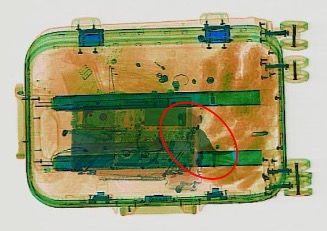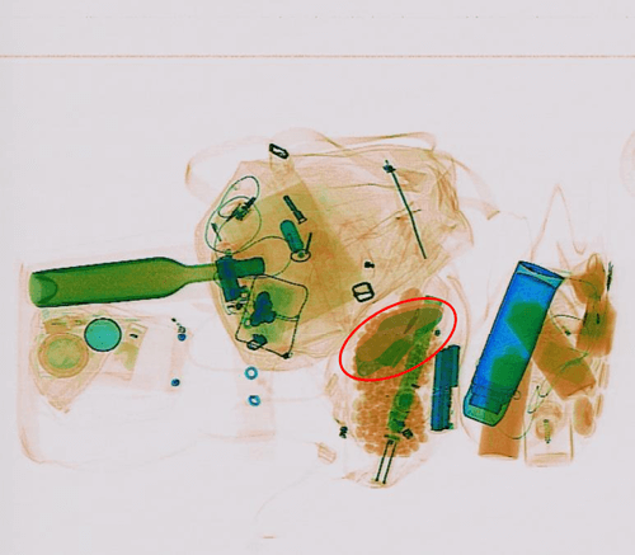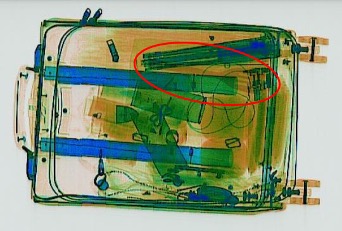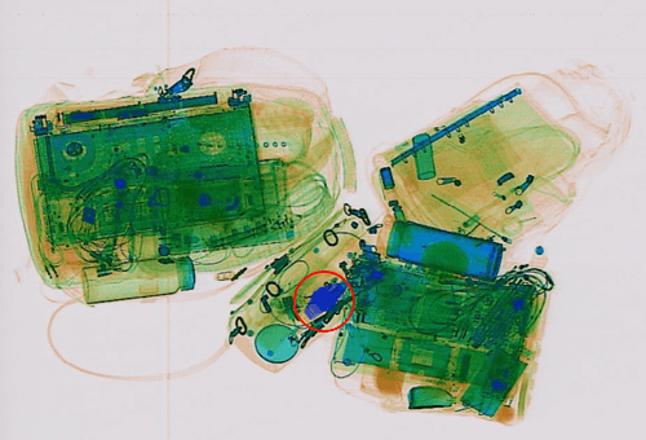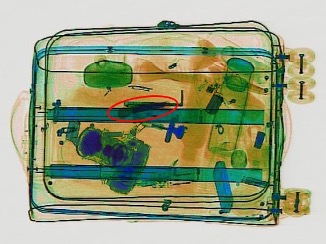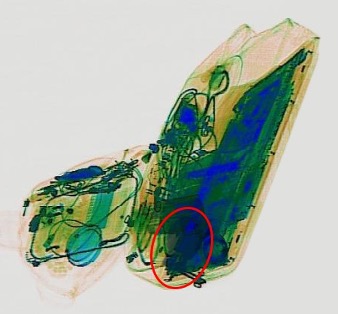What Is the TSA CBT Test?
The TSA CBT (Computer-Based Test) is a required pre-employment exam used by the Transportation Security Administration to assess candidates applying for the role of Transportation Security Officer (TSO). It includes either a traditional version with X-ray image analysis and English skills assessment or a newer short version testing spatial and cognitive abilities. Passing the TSA CBT is essential to move forward in the TSA hiring process.
What’s on the TSA Test (2025)?
There are two versions of the TSA CBT, depending on your test location:
| Feature | Traditional TSA Test | Short TSA Test |
|---|---|---|
| Length | 2.5 hours | 25–45 minutes |
| Where Taken | Most TSA centers | Select airports |
| Includes English Test | Yes | No |
| Includes X-Ray Test | Yes | No |
| Visual-Spatial Tasks | No | Yes (3 sections) |
| Skills Measured | Grammar, reading, vocab, X-ray | Shape folding, image matching, connect-the-dots |
| % of Test-Takers | ~90–95% | ~5–10% |
How to Know Which TSA Test You’ll Take
Check your Pearson VUE scheduling email. If it includes the line:
“This assessment is not an English language proficiency assessment”
you’re scheduled for the short TSA test. Otherwise, expect the full TSA CBT with English and X-ray sections.
TSA CBT Practice Questions
If you're taking the short version of the TSA test, you'll face three timed visual challenges:
-
2D to 3D Shape Folding
-
Image Matching
-
Connect the Dots (Letters, Numbers, Mixed)
If you're preparing for the traditional TSA CBT, your focus should be:
-
X-ray Object Recognition (identifying weapons, tools, or banned items in luggage)
-
English Skills Assessment:
-
Grammar and syntax
-
Reading comprehension
-
Vocabulary (synonyms, antonyms)
-
Practice tests for both versions help improve your speed, focus, and confidence.
TSA Shape Folding Questions – Practice & Tips
In these TSA CBT test questions, you are given a flat, 2D shape (often with markings or labels on various segments) and asked to visualize how it would look when folded into a 3D object. You will be asked to match numbers on the faces of the 2D shape to the corresponding letters on the faces of the folded 3D shape.
2D to 3D Sample Question
Take a look at this sample question and see if you can solve it:
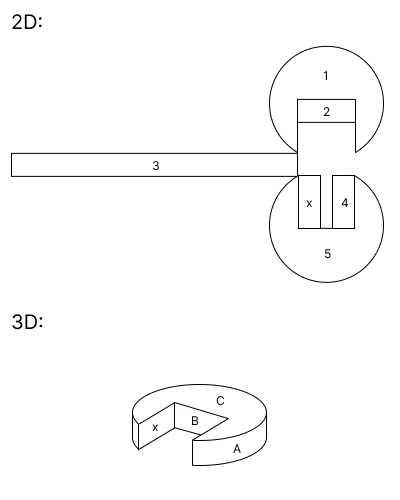
A = ? | B = ? | C = ?
Figure Folding requires methodical work, attention to detail, and an understanding of 3D figures. In the second example, while some 3D components overlap, the shape that connects them is unique, making it easier to track. Developing a methodical workflow will improve your accuracy. Find many examples in our All-Inclusive TSA CBT PrepPack.
TSA Image Matching Practice Questions
In Shape Match questions, you are given a target shape and must quickly identify the matching shape from a series of other shapes. The matching shape may be rotated or scaled, adding to the complexity. On the actual TSA CBT exam, time counts forward. While there's no time limit, answering quickly can improve your score.
Shape Match Sample #1
Here is an example, take a look and try to identify the matching figure as fast as you can:


Shape Match Sample #2
The complexity of the question may also increase, as shown in the following example:
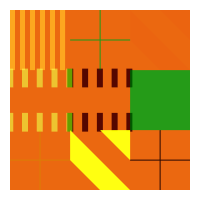

Tip
To answer quickly, narrow down the options by elimination. Scan the patterns from top-left going clockwise, and identify distinctive features. If there are multiple possible answers, refine your choices further using pattern differentiation techniques.
TSA Connect-the-Dots Test Free Practice
On these TSA CBT test questions, you are presented with numbers and/or letters scattered on the screen. You'll need to connect them numerically (1-2-3...), then alphabetically (A-B-C...), and finally sequentially (1-A-2-B-3-C...). This section of the TSA computer-based test assesses your speed and accuracy. It primarily focuses on the ease of switching between the alphabetical and numerical tasks.
It is similar to a common assessment of task shifting known as the Trail Making Test.

Take Full-Length TSA CBT Practice Tests
The shorter TSA exam emphasizes speed and precision. Our TSA test practice materials enhance these skills through full-length practice tests created by psychometric experts. Our TSA CBT test prep includes both the legacy X-ray & English TSA test versions, ensuring comprehensive TSA test preparation.
The New TSA Test Practice-
- 2D to 3D shape folding practice tests (6)
- Image matching practice tests (4)
- Connect the dots practice tests (5)
X-ray & English TSA Test Practice:
- 14 X-ray practice tests
- Guidance for item recognition
- 47 extra drills (vocabulary, writing, grammar)
Navigate Through JobTestPrep's Aviation Category
TSA X-Ray Test: How It Works
The X-ray section of the TSA Computer-Based Test (CBT) is one of the most challenging parts of the exam. It’s designed to test your ability to identify potential threats inside passenger luggage using color-coded images. This section is part of the traditional 2.5-hour TSA CBT, alongside an English assessment, and is administered at TSA testing centers.
- Duration: 15 seconds per image
- Question Types: Identify whether a specified item (e.g., gun, knife, water bottle) appears in the image
- Scoring: Based on accuracy and speed. Incorrect guesses or missed threats can reduce your score
You'll see scanned images of bags containing both harmless and prohibited items. Your job is to quickly and confidently decide if the target item is present.
TSA X-Ray Test Colors & Examples
The TSA X-Ray test (also used by GardaWorld) images are color-coded based on material density:
| Color | Meaning | Sample Questions |
|---|---|---|
| 🔵 Blue | Dense / Metal | Q1 (Wrench), Q5 (Key - Missing), Q10 (Watch) |
| 🟢 Green | Medium Density / Plastic | Q3 (Toy), Q4 (Pen), Q11 (Electronic Device) |
| 🟠 Orange | Organic Material (Wood/Food) | Q2 (Kitchen Tool), Q6 (Shoe), Q8 (Spatula) |
| 🔴 Red | Low-Density (Paper/Fabric) |
💡 Important: Focus on structural features over color. Some items may appear in unexpected shades depending on their composition. Focus on structure and outline.
What Items Appear on the TSA X-Ray Test?
The test mixes everyday items with potential threats. You may be asked to find or rule out:
- Tools: wrench, screwdriver, spatula
- Household items: pen, key, shoe, watch
- Electronics: charger, headphones, flashlight
- Weapons: knife, gun, grenade
Let’s go through sample questions so you can get a feel for what to expect.
TSA X-Ray Practice Questions
X-Ray Sample Question #1
Can you identify a wrench in the X-ray image?
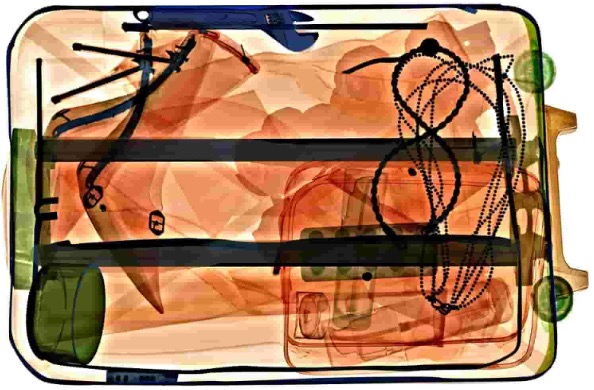
X-Ray Sample Question #2
Can you identify a Kitchen Tool in the X-ray image?
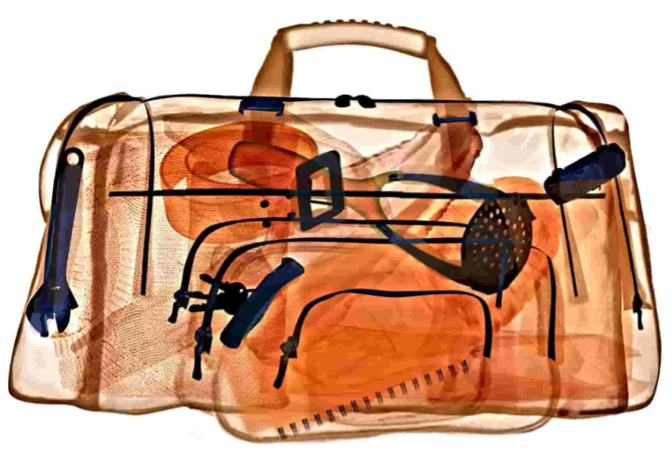
X-Ray Sample Question #3
Can you identify a toy in the X-ray image?
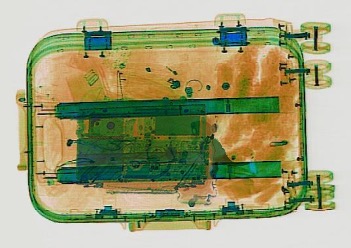
💡 Avoid memorizing the item's colors as they may change from one question to the next depending on the item's specific materials and densities – as can be seen in the following questions.
X-Ray Sample Question #4
Can you identify a pen in the X-ray image?
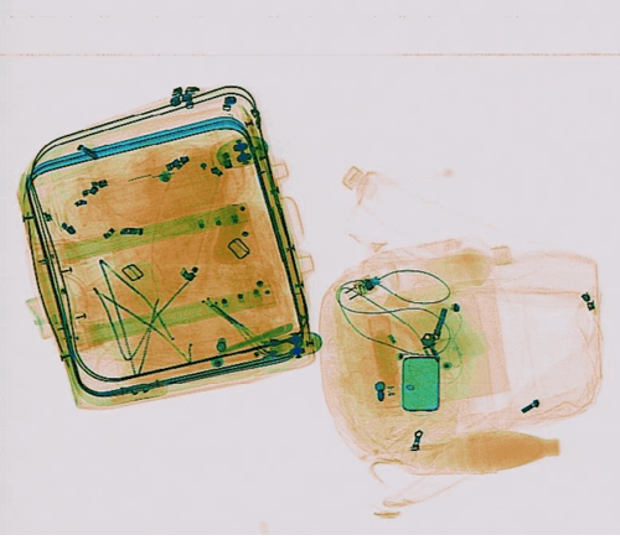
X-Ray Sample Question #5
Can you identify a key in the X-ray image?

How can you be certain of your observation?
If there was a key in the image, it would probably appear in blue (since it is made of metal). Like the TSA CBT exam, our practice test contains images with no concealed items. You must be able to memorize the different traits and structures you are looking for to quickly rule out the presence of items in the images.
Some images may be more challenging, with items that are more difficult to identify. See if you can spot the requested item in the following question:
X-Ray Sample Question #6
Can you identify a shoe in the X-ray image?
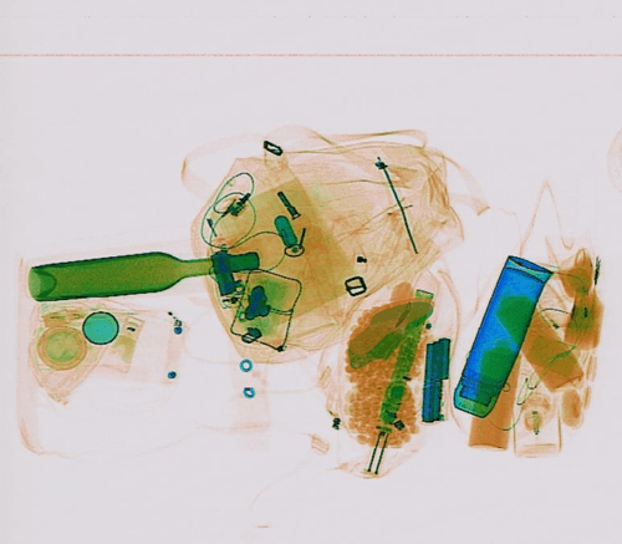
Tips for Practicing Luggage Scanning
Search the items using a method to make sure you don't miss anything. Try scanning the bags in snake-like movements or dividing the suitcase into four parts and searching each one separately. Don’t forget to examine the outlines of the luggage for items that might be hidden there.
Guided TSA X-Ray Test Practice and Simulations
If you are preparing for the TSA Test, our comprehensive TSA test prep package has got you covered with many more tips and detailed guidance on what to look for in X-ray questions. Inside, you will also find practice tests for varied X-ray images, English questions, and the shorter TSA test version.
Now try to solve this next set of questions, with different items to identify:
X-Ray Sample Question #7
Can you identify a water bottle in the X-ray image?

X-Ray Sample Question #8
Can you identify a kitchen tool in the X-ray image?
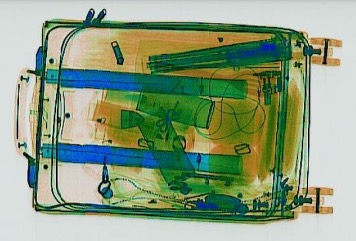
X-Ray Sample Question #9
Can you identify a work-tool in the X-ray?
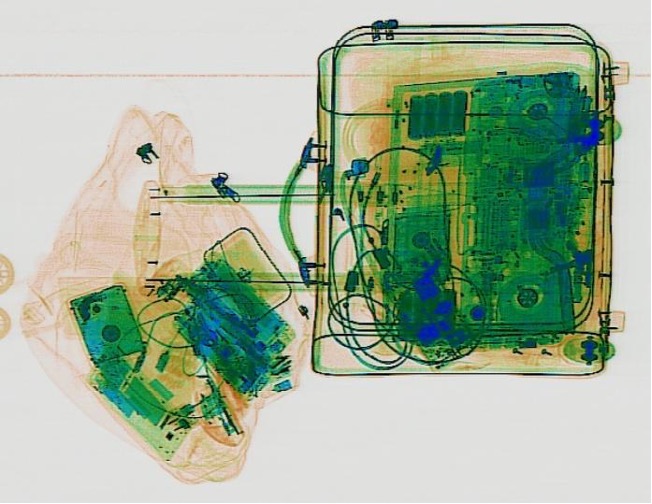
Some items such as water bottles are more distinct, and as seen in the examples above, their absence is clear. In the second example, common knowledge (spatula being made of wood) can be utilized to answer the question successfully. However, there are a variety of working tool items that may be more challenging to identify.
In our TSA Preparation Pack, you will find a variety of items and guidelines to help you learn about the features of different tools, so you are able to recognize any described item during the X-ray test.
Now try this next set of questions, with new and varying items:
X-Ray Sample Question #10
Can you identify a watch in the X-ray image?
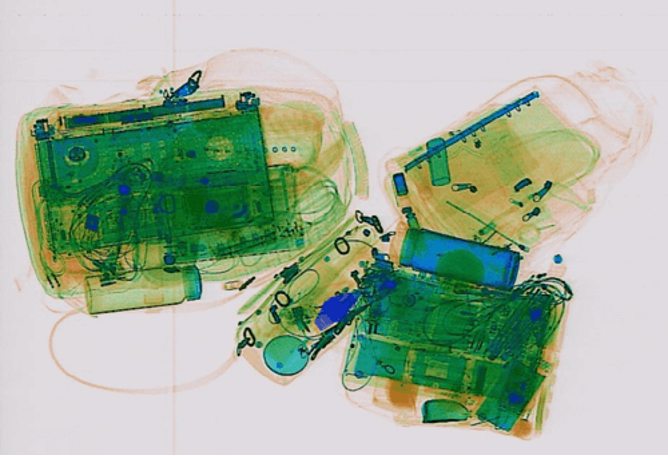
X-Ray Sample Question #11
Can you identify an electronic device in the X-ray image?

💡 Note – here you can spot a distinctive metal water bottle. However, since the question requires finding an electronic device, you should ignore the water bottle and any item that is not an electronic device. Make sure to always read and follow the instructions before each question.
What traits should you look for to find electronic items?
A plug: pay attention to the different kinds of plugs (EU, US, AU, UK)
Colors: Many electronic items have a plastic wrap and inside of it are metal parts. The density of the metal parts shows as green or blue, so you can notice the chips, batteries, wires, and other metallic components inside the electronic object.
X-Ray Sample Question #12
Can you identify a knife in the X-ray image?
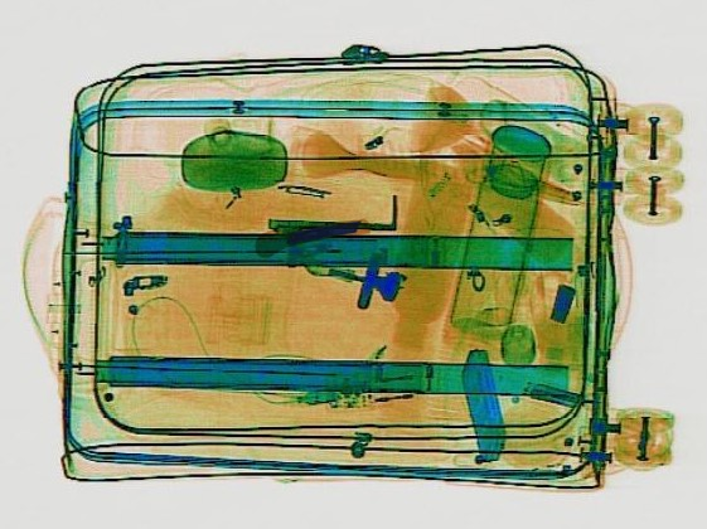
💡 An important note about knives:
On the actual TSA Computer-Based Test, you'll need to identify different kinds of knives, from large knives to utility knives, sharp nail filers, and even scissors. All these examples and more can be found in the wide variety of questions in our complete TSA Preparation Pack.
X-Ray Sample Question #13
Can you identify a gun in the X-ray image?
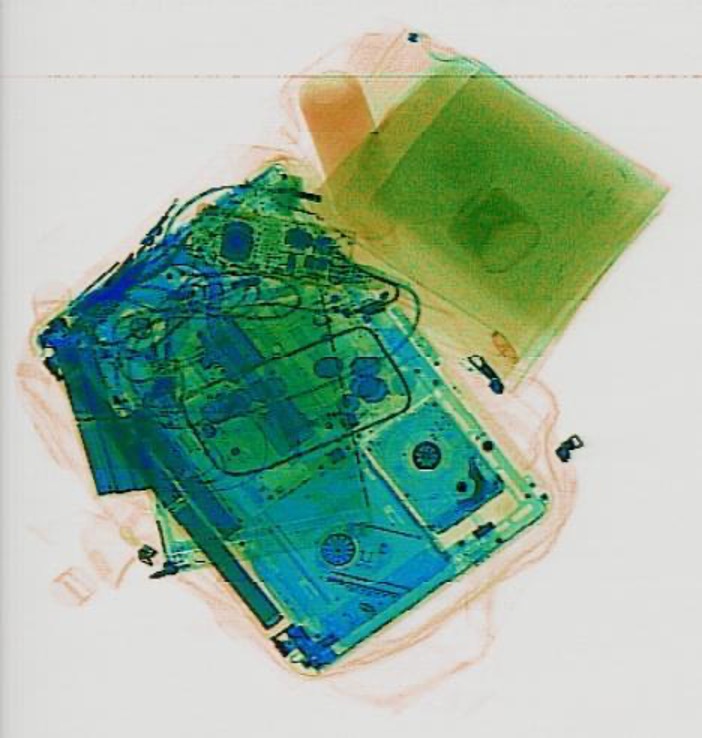
Tips for Identifying Guns in an X-Ray Image Interpretation Test
Guns come in different sizes, types, and colors. Most of the types share the same distinctive features which can allow you to identify them on an X-Ray scan:
- Slide: It is usually the densest part of the gun, and therefore it usually has the darkest color.
- Trigger: It may be hidden in some angles, while in other X-Ray scans, it may become a distinctive feature crucial to identify the gun.
- Grip: This is the part used to hold the gun. It includes a space designated for a magazine.
X-Ray Sample Question #14
Can you identify a grenade in the X-ray?

💡 Don't rely solely on the grenade's color
Usually, the body of the grenade appears in green or blue. However, it is better to learn to identify its parts rather than relying on the colors, as they may look different in other X-Ray machines. Since the grenade may vary in shape, it is best to learn the different structures of different grenades and be prepared to identify them in any variation in the real test.
Tips for X-Ray Images
- Scan methodically: Move left to right or break the image into quadrants so you don’t miss small or rotated items.
- Focus on shape, not just color: Materials may show up in unexpected colors depending on density.
- Look for types, not exact matches: A knife or shoe might look different from the preview — train yourself to spot the category.
- When in doubt, leave it out: Don’t mark an item unless you’re confident it's there. Random guessing lowers your score.
- Expect color or angle variations: Some images may be grayscale or contain overlapping items at odd angles — stay flexible.
- Train for unpredictability: You may see unfamiliar items or designs. Rely on key traits, not exact replicas.
Free TSA CBT English Test Practice
The TSA screener English test (also known as the TSA Writing Skills Assessment) includes Reading Comprehension, Vocabulary, and Written Communication. Your TSA exam may contain some or all of these topics.
💡 Tips for Reading Comprehension:
- Read the questions first before reading the passage.
- Answer the easiest questions first.
- Base all answers strictly on the passage—do not assume external knowledge.
💡 Tips for Synonym & Antonym Questions:
- Eliminate at least two answer choices with similar meanings.
- Use prefixes & suffixes to determine meanings.
- For antonyms, first identify if the given word has a positive or negative connotation.
TSA Reading Comprehension Practice Questions
Read the following passage and try answering the questions below:
A growing body of research suggests that the regular, high-level use of more than one language may actually improve early brain development. According to several different studies, a command of two or more languages aggrandizes the ability to focus in the face of distraction, decide between competing alternatives, and disregard irrelevant information. These essential skills are grouped together, known in brain terms as ‘executive function’ and research suggests they develop ahead of time in bilingual children. While no one has yet identified the exact mechanism by which bilingualism boosts brain development, the advantage likely stems from the bilingual’s need to continually select the right language for a given situation.
1. The research suggests that ‘executive function’ increases with the number of languages mastered.
- True on the basis of the passage.
- False on the basis of the passage.
- Not possible to say if the statement is true or false on the basis of the passage.
Answer:
The correct answer is (3).
The passage mentions differences expected in the ‘executive functions’ of the brain between children who have command of a single language and children who have mastered more than one.
However, it cannot be inferred that this effect continues as the number of languages continues to grow. For instance, it is not clear whether the difference in executive functions is also present between children who have command of two languages and children who have command of more than two languages.
2. Which one of the following provides the best summary of the main point of the passage?
- It’s recommended to know more than one language.
- Bilingualism has significant advantages.
- Bilinguals have difficulties selecting the right language
- Bilingualism contributes to the development of ‘executive functions’.
Answer:
The correct answer is (4).
The passage introduces two main themes: bilingualism and ‘executive functions’, emphasizing how the two are connected. The only distracter that offers insight into this connection is D.
All three remaining distracters focus either on bilingualism or ‘executive functions’, failing to acknowledge the essence of the passage.
💡 Tips for Reading Comprehension questions
- Read the questions before the passage. This will help you understand what you should be looking for in the text.
- Choose the easiest questions first. For example, a question asking what a word means in the given context or a question asking how two statements are related.
- Don’t try to assume anything outside of the text. Everything you need to answer each question can be found within the passages themselves. Disregard any answer that is not supported by the text.
- For 'True/False/Cannot Say' questions, if you are having trouble answering any question, the most likely answer will be 'cannot say'.
TSA Grammar Test – Error Detection Practice
Identify which type of error appears in the sentence below:
3. Mrs. Qualitrix's meeting has been postponed, due to a doctor's appointment.
- Grammar
- Spelling
- Punctuation and capitalization
- No error
Answer:
The correct answer is (3) - punctuation and capitalization.
According to the English language's punctuation and capitalization rules, a comma should never separate the subject and the verb. The correct way to write the sentence -is "Mrs. Qualitrix's meeting has been postponed due to a doctor's appointment" without any commas.
Identify which type of error appears in the sentence below:
4. The heat of the desert affected the traveler greatly, and he regretted not leaving with the professor whom had offered him a ride to the city.
- Grammar
- Spelling
- Punctuation and capitalization
- No error
Answer:
The correct answer is (1).
According to the English language's grammar rules, 'whom' should be applied when the noun refers to objects rather than the sentence's subject.
If you can replace the word with "she" or "he," use "who." if you can replace it with "her" or "him," use "whom." In this part of the sentence – "the professor… had offered him a ride" – the professor is the subject, and the traveler is the object.
Common grammar mistakes you should be familiar with:
1. Adding a comma where it's inappropriate or forgetting to add a comma where needed.
2. Pronoun disagreement: for example - "Every TSA agent must wear their own badge."
3. Mistakes in apostrophe usage.
4. Sentence fragments- sentences without a subject and a verb.
5. No clear antecedent. For example - "The TSO found the passenger's Swiss knife, and he was surprised."
7. Mixing up spellings, such as you're/your, to/too, there/their, etc.
8. Capitalization mistakes.
TSA Vocabulary Questions – Synonyms & Antonyms
5. Pecuniary most nearly means
- Affection
- Scant
- Unique
- Monetary
Answer:
The correct answer is (4).
Pecuniary is related to money or banking, and means financial or monetary, as suggested by option 4.
6. IMPERIOUS is the opposite of...
- Arrogant
- Moody
- Subservient
- Quiet
- Stormy
Answer:
The correct answer is (3).
Imperious means "domineering in a haughty manner; dictatorial; overbearing," so the antonym is subservient. Arrogant is a similar word but not a synonym. Quiet and stormy are not related.
Therefore, the correct answer is subservient.
💡 Tips for Synonym and Antonyms Questions:
- Eliminate at least two answer choices that are synonyms or close to each other. If they have close meaning, it means that they're not the correct answer.
- Watch for the suffix and prefix of words to help you understand the meaning of a word. For example, the prefix "de" means "reverse" or "change" (declassify, demotivate, etc.), and the prefixes il/im/in/ir mean "not" (illegal, insecure, etc.).
- In Antonym questions, eliminate words based on their positive or negative meanings. If the given word is positive, you can quickly eliminate all the answers that have a positive connotation and vice versa.
The English section, as can be seen, is very different from the first part of the test. It requires a completely different set of skills: the ability to assess and make assumptions, as well as vocabulary and grammar skills. Additional texts, practice questions, and tests, alongside guides and tips for succeeding in this section can be found in our full TSA Test Prep.
Get More Practice for Both TSA CBT Test Versions
Our TSA CBT test prep prepares you for both the short TSA exam and X-ray TSA test, ensuring high-speed accuracy and X-ray image analysis proficiency.
Newer TSA Test Practice (Aptitude):
- 3 Shape folding practice tests + 3 extra tests
- 4 Image matching practice tests
- 5 Connect the dots practice tests
TSA X-Ray & English Test Practice: - 14 X-ray practice tests (simulating the TSA computer-based test)
- Guides with TSA-specific item identification tips
- 47 drills to improve English test skills
- 7 TSA test practice simulations
For more vocabulary assessing exams, check out our Free Wonderlic Test Practice.
How to Pass the TSA CBT – Expert Tips
Below you'll find valuable resources for the other steps you need to pass during the Transportation Security Administration hiring process.
TSA Hiring Process – What Happens After the Test?
The entire process may take anywhere from 6 months to 2 years.
The application timeline for the TSA varies depending on the number of vacancies in the government department.
You may submit your application online and wait months to hear back from the TSA before a vacancy in your area becomes available. However, if an opening opens immediately, you could hear from the department the next day.
The length of the hiring process is also determined by how well you do on the TSA CBT (Computer-Based Test). Candidates with higher scores get job offers more quickly.
TSA CBT FAQs
The TSA Computer-Based Test (CBT) is an exam used during the hiring process for Transportation Security Officers (TSOs). It includes an X-ray object recognition test and an English language assessment. Some applicants may receive a shorter version focused on cognitive skills.
Your Pearson VUE scheduling email usually includes a note. If it says, “This assessment is not an English language proficiency assessment,” you’ll take the short, visual-based version. If not, expect the full 2.5-hour test with English and X-ray sections.
Many candidates find the X-ray section especially challenging, since it’s unlike anything they’ve done before. With focused preparation, most candidates improve their accuracy and confidence quickly.
The TSA doesn’t publish official passing scores. However, candidates are grouped into categories: Best Qualified, Highly Qualified, and Qualified. Scoring in the top group gives you the best chance of advancing quickly.
Use full-length practice tests that reflect the actual question formats. Practice X-ray object recognition under time pressure, and review key English grammar and vocabulary skills.
Yes! Our TSA CBT practice test is completely free and includes sample questions that reflect the real test format.
Our test was developed by psychometric experts and closely mirrors the real exam's format, timing, and difficulty level. Many users report that the practice test feels very similar to the actual experience.
The number of questions varies slightly by version. The full version includes approximately 100 X-ray questions and 50–60 English questions. The short version includes 15–25 cognitive tasks across three sections.
The traditional version lasts about 2.5 hours. The short version, used at select airports, takes 25–45 minutes.
If you fail or miss your scheduled exam, you’ll be disqualified from applying again for six months. After two failed attempts, you may become ineligible to apply for a TSO role at all.
You’ll move on to the next stage of the hiring process, which may include an airport assessment, credit and background checks, a medical evaluation, drug screening, and formal training.
Regular practice, time management, and focusing on weak areas—especially X-ray image interpretation—are key to maximizing your score.
TSOs (Transportation Security Officers) screen passengers and luggage at U.S. airports to ensure public safety.
Starting Salary: ~$37,000–$42,000/year
With Experience: $50,000+ possible (incl. overtime)
Benefits: Paid training, health insurance, federal retirement plan, and advancement opportunities
Passing the TSA test is required to qualify for this role.
Why 21,700+ Candidates Trust This Prep
If you are looking for a different test, or are not sure which test is relevant for your position, contact us, and we'll do our best to ensure you get the most accurate preparation for your upcoming exam.


